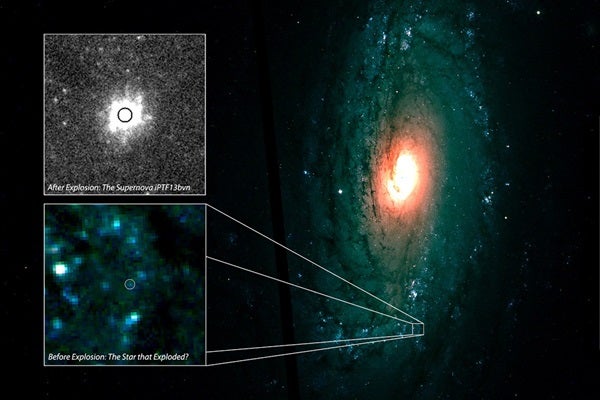The iPTF builds on the legacy of the Caltech-led Palomar Transient Factory (PTF), designed in 2008 to systematically chart the transient sky by using a robotic observing system mounted on the 48-inch Samuel Oschin Telescope on Palomar Mountain near San Diego, California. This state-of-the-art robotic telescope scans the sky rapidly over a thousand square degrees each night to search for transients.
Supernovae — massive exploding stars at the end of their life span — make up one important type of transient. Since PTF’s commissioning four years ago, its scorecard stands at over 2,000 spectroscopically classified supernovae. The unique feature of iPTF is new technology that is geared toward fully automated, rapid response, and follow-up within hours of discovery of a new supernova.
Type Ib supernovae are rare explosions where the progenitor star lacks an outer layer of hydrogen, the most abundant element in the universe — hence the “stripped envelope” moniker. It has proven difficult to pin down which kinds of stars give rise to type Ib supernovae. One of the most promising ideas, according to Yi Cao from Caltech, is that they originate from Wolf-Rayet stars. These objects are 10 times more massive and thousands of times brighter than the Sun and have lost their hydrogen envelope by means of strong stellar winds. Until recently, no solid evidence existed to support this theory. Cao and colleagues believe that a young supernova that they discovered, iPTF13bvn, occurred at a location formerly occupied by a likely Wolf-Rayet star.
Supernova iPTF13bvn was spotted June 16, less than a day after the onset of its explosion. With the aid of the adaptive optics system used by the 10-meter Keck telescopes in Hawaii, which reduces the blurring effects of Earth’s atmosphere, the team obtained a high-resolution image of this supernova to determine its precise position. Then they compared the Keck image to a series of pictures of the same galaxy (NGC 5806) taken by the Hubble Space Telescope in 2005 and found one starlike source spatially coincident to the supernova. Its intrinsic brightness, color, and size, as well as its mass-loss history, inferred from supernova radio emissions, were characteristic of a Wolf-Rayet star.
“All evidence is consistent with the theoretical expectation that the progenitor of this type Ib supernova is a Wolf-Rayet star,” said Cao. “Our next step is to check for the disappearance of this progenitor star after the supernova fades away. We expect that it will have been destroyed in the supernova explosion.”
Though Wolf-Rayet progenitors have long been predicted for type Ib supernovae, the new work represents the first time researchers have been able to fill the gap between theory and observation, according to Mansi Kasliwal, Caltech alumna. “This is a big step in our understanding of the evolution of massive stars and their relation to supernovae.”
Meanwhile, Leo Singer from Caltech describes finding and characterizing the afterglow of a long gamma-ray burst (GRB) as being similar to digging a needle out of a haystack.
Long GRBs, which are the brightest known electromagnetic events in the universe, are also connected with the deaths of rapidly spinning massive stars. Although such GRBs initially are detected by their high-energy radiation — GRB 130702A, for example, was first located by NASA’s Fermi Gamma-ray Space Telescope — an X-ray or visible-light afterglow must also be found to narrow down a GRB’s position enough so that its location can be pinpointed to one particular galaxy and to determine if it is associated with a supernova.
After Fermi’s initial detection of GRB 130702A, iPTF was able to narrow down the GRB’s location by scanning an area of the sky over 360 times larger than the face of the Moon and sifting through hundreds of images using sophisticated machine-learning software; it also revealed the visible-light counterpart of the burst, designated iPTF13bxl. This is the first time that a GRB’s position has been determined precisely using optical telescopes alone.
After making the initial correlation between the GRB and the afterglow, Singer and colleagues corroborated their results and gained additional information using a host of other instruments, including optical, X-ray, and radio telescopes. In addition, ground-based telescopes around the world monitored the afterglow for days as it faded away and recorded the emergence of a supernova five days later.
According to Singer, GRB130702A/iPTF13bxl turned out to be special in many ways. “First, by measuring its redshift, we learned that it was nearby as far as GRBs go,” he said. “It was pretty wimpy compared to most GRBs, liberating only about a thousandth as much energy as the most energetic ones. But we did see it eventually turn into a supernova. Typically, we only detect supernovae in connection with nearby subluminous GRBs, so we can’t be certain that cosmologically distant GRBs are caused by the same kinds of explosions.”
“The first results from iPTF bode well for the discovery of many more supernovae in their infancy and many more afterglows from the Fermi satellite,” said Shrinivas Kulkarni from Caltech.










